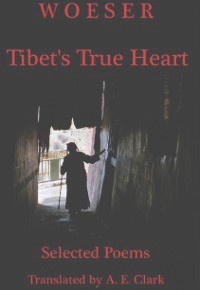The Damshung earthquake does not call for thanks
Some Tibetans have mentioned online what the Astronomical Almanac of the Tibetan Calendar, published by Tashilhunpo Monastery in Tsang, had to say about this year, the Year of the Earth Rat. The almanac predicted that “all year there will be storms and earthquakes” and “there will be many earthquakes and much brigandage.” Considering the many extraordinary natural phenomena and social upheavals which have occurred so far, one has to be struck by the accuracy and merit of this thousand−year−old system of calendrical divination. In contrast, the seismological bureau has monitoring stations established all over to provide early warning and presents itself as a modern scientific organization, but it has been closing the barn door only after the horse is gone.
On October 6, in Damshung county not far from Lhasa, there occurred an earthquake that measured 6.6 on the Richter scale and affected Lhasa, Shigatse, and other places — they all felt distinct tremors. According to a subsequent report by the T.A.R. seismological bureau, by noon on Oct. 10 there had been over a thousand aftershocks in Damshung, two of them exceeding 5.0 on the scale, the largest being measured at 5.4. In May the big quake in Wenchuan had caused enormous loss of life and property, and all the media continuously bombarded people's minds with words and images about it, inflicting a kind of shock so that people’s minds have become overshadowed with the horror and awesome power of earthquakes. In recent days in Lhasa for example, the popular anxiety is such that schools are letting out early or closing altogether, and open spaces like Potala Square or Jokhang Square are either jammed with parked vehicles or thronged with people. Each time, the earthquakes strike suddenly, and since no timely warning is to be had, people protect themselves as best they can. I’ve heard one way is to paint a swastika with lime in a high part of the house and place a white porcelain bowl full of white rice in the center of the swastika. The swastika is a symbol of the Bön religion, which draws together every kind of divinity in heaven and earth, and this act is probably a reverent and propitiatory offering.
The authorities, who call themselves atheist, will surely scoff at this. Let us consider their reactions in the last few days. The official media initially reported 30 dead in the disaster area, but a few hours later corrected the figure to 10 dead. How could the discrepancy be so large? The official media don’t seem to have offered any explanation, but at that time mobile phone users in Lhasa received a text message that strictly forbade the spreading of rumors. Yet this particular rumor originated in the official media. It’s odd that Radio Free Asia’s Tibetan Service, when it undertook to report what was happening at the local hospital in Damshung, found the casualties a closely−guarded secret. Why? For what motive? An earthquake is a natural disaster: how did it become something that can’t be talked about? It’s worth noting that the reports filling the official media are all encomiums: in all the pictures what you mostly see is officials, PLA personnel, paramilitaries, and police, who’ve all become heroes of the relief effort. But before this happened, on account of the large−scale protests that had erupted all over the Tibetan region in March, the army and the police were sweeping the region, heavily armed, in a campaign that laid bare their essential character as thugs hired to suppress the masses. Like night and day. It sure seems to be an attempt to whitewash the odious image of the army and the police, as there’s no indication that the authorities have had any change of heart. Since they are in control, disaster relief is their public duty. But the authorities are always skilled at turning trouble to good account, adept at making the masses feel grateful amid tears of pain. This ‘culture of obligation’ with Chinese characteristics is revealed not only during the earthquake but in the way the earthquake would be talked about later, talked about for days, for months, for years. Just you wait and see.
Lately, experts in seismology have been saying that the unique geological structure of the Tibetan Plateau gives rise to frequent seismic episodes. In the most recent time frame, they say, there was seismic activity in the eastern half of the plateau, but one couldn’t conclude from this that even bigger earthquakes were going to strike southeastern Tibet in September or October. In other words, according to them, the earthquakes were either going to happen or they were not going to happen. Faced with these natural disasters, the inhabitants of the Tibetan Plateau have no other hope than to get better information, in a more timely fashion, about earthquakes. They have a right to know.
A few further suggestions:
- Permit international media to enter and report from disaster areas, relaying the extent of the earthquake damage and the impact of humanitarian aid.
- Accept humanitarian assistance from international organizations and overseas Tibetan groups.
- Since current reporting plays up, to a tune of thanksgiving, scenes of leaders giving comfort or soldiers and police effecting rescues, and one seldom sees an honest and genuine reflection of what the disaster victims are actually saying and demanding, it is to be hoped that journalists in the official media will enter more deeply into the situation of the people in order to understand their hardships.
Woeser wrote this article for Radio Free Asia’s Tibetan−language service. It was posted to her blog on October 15, 2008.
Translator’s Notes
This article implies that the authorities of the PRC could have given the public advance warning of the earthquakes which shook Sichuan in May and the Tibet Autonomous Region in October. Many Western readers will find this questionable in light of the still limited capabilities of seismology. But in the PRC, across various classes and ethnicities, this opinion (that the authorities must have known) is widely and firmly held. Perhaps it can be ascribed to the State's effectively unlimited power in matters of national security, combined with a lack of transparency. A historical event is relevant, however. In 1975, in the northeastern city of Haicheng, an earthquake of magnitude 7.3 was preceded — as most major earthquakes are not — by a series of foreshocks which prompted an evacuation of the city on the day before the massive quake struck. This extraordinary success (which was, naturally, well-publicized) may have planted in Chinese minds the conviction that the authorities possess the means to predict earthquakes precisely. The disaster which occurred at Tangshan in the following year did not eradicate this belief. Ruth Ludwin provides an overview of the scientific issues for laymen. Nature magazine hosted an extended discussion in 1999.
Astronomical Almanac of the Tibetan Calendar. This genre, called Loto in Tibetan, is popular throughout Greater Tibet. Printed on short wide pages in the style of the traditional pecha, each of these books serves as a Farmer's Almanac cum horoscope. They are published by a variety of monastic institutes and medical colleges.
Tashilhunpo Monastery in Tsang. This is the seat of the Panchen Lama. At one time the areas surrounding Lhasa (namely, Ü) and Shigatse (namely, Tsang) were sharply distinguished. Of the old Chinese names for these districts, Qian Zang and Hou Zang (Fore Tsang and Rear Tsang), the latter has remained in informal use.
closing the barn door only after the horse is gone The Chinese saying is more martial: “shooting at the [cavalry] horse after it gets away.”
to paint a swastika Although tainted in the West by its adoption as a Nazi emblem, the swastika is an ancient Indian symbol of good fortune which became particularly significant in Bön, the indigenous religion of Tibet. Woeser uses the Tibetan word yongzhong and explicitly connects the symbol with Bön. See Robert Beer, The Encyclopedia of Tibetan Symbols and Motifs, London, Serindia Publications 1999, (p. 344). For an introduction to the Bön religion see Per Kvaerne, The Bon Religion of Tibet: the Iconography of a Living Tradition, London, Serindia Publications 1995.
culture of obligation Woeser’s term, enren zhengzhi (literally, “benefactor politics”), refers to the keen awareness of obligations which characterizes the cultures of East Asia.


